Potřebujeme váš souhlas k využití jednotlivých dat, aby se vám mimo jiné mohly ukazovat informace týkající se vašich zájmů. Souhlas udělíte kliknutím na tlačítko „OK“.
ASTM D7899-13
Standard Test Method for Measuring the Merit of Dispersancy of In-Service Engine Oils with Blotter Spot Method
Automaticky přeložený název:
Standardní zkušební metoda pro měření zásluhy o disperzní v provozu motorových olejů s piják Spot metodou
NORMA vydána dne 1.12.2013
Informace o normě:
Označení normy: ASTM D7899-13
Poznámka: NEPLATNÁ
Datum vydání normy: 1.12.2013
Kód zboží: NS-39251
Počet stran: 7
Přibližná hmotnost: 21 g (0.05 liber)
Země: Americká technická norma
Kategorie: Technické normy ASTM
Kategorie - podobné normy:
Anotace textu normy ASTM D7899-13 :
Keywords:
condition monitoring, diesel engine oils, dispersancy, in-service petroleum lubricants, lubricants, oils, oxidation, soot, ICS Number Code 75.100 (Lubricants, industrial oils and related products)
Doplňující informace
| Significance and Use | ||
|
5.1 Dispersancy is the property that allows oil to suspend and carry away pollutants of diverse sources such as soot from combustion, metallic particles from wear, corrosion of mechanical parts, and insoluble products resulting from the aging of the oil. 5.2 When poured on a specific filter paper, oil that is properly dispersing soot and other insolubles produces an evenly graduated spot. The distribution of the different zones (5.3 While the oil spreads out on the filter paper, the oil carries contaminants, and due to the lamination phenomenon of the oil film, the particles of same size deposit on the paper on the same concentric zones. 5.4 This test method provides a simple technique for condition monitoring of the dispersancy property of in-service lubricants. 5.5 An oil that is properly dispersing soot and other insolubles produces an evenly graduated blotter (see 5.6 A blotter indicating a high soot load, but even graduation, suggests the oil is still fit for service, but should be watched closely for degradation (see 5.7 When dispersancy begins to fail, the insolubles begin to form a dense ring on the exterior of the absorbing oil drop as in 5.8 Fig. 2—Spot 4 indicates the characteristic dense black dot and sharp periphery that indicates sludge and the loss of dispersancy as the particles have settled in the center and the oil has wicked outward. 5.9 From a maintenance perspective, when the ring begins to form around the exterior of the oil blotter, it is time to look at scheduling a drain. If the black dot is allowed to form, the situation is problematic because the undispersed portion of soot that has deposited upon surfaces will not be removed by the oil change. Often, several changes made at frequent intervals will be required to effectively scour the engine clean. Also, if dispersancy performance degrades at an unusually rapid pace, a more extensive review of combustion and ring performance should be undertaken. |
||
| 1. Scope | ||
|
1.1 This test method covers a procedure for determination of the merit of dispersancy of diesel crankcase engine oils as well as other types of engine oils where pollutants of diverse sources such as soot from combustion, metallic particles from wear, corrosion of mechanical parts, and insoluble products resulting from the oxidation of the oil may contaminate the lubricant. 1.2 The values stated in SI units are to be regarded as standard. No other units of measurement are included in this standard. 1.3 This standard does not purport to address all of the safety concerns, if any, associated with its use. It is the responsibility of the user of this standard to establish appropriate safety and health practices and determine the applicability of regulatory limitations prior to use.
|
|
Standard Practice for Set-Up and Operation of Fourier Transform Infrared (FT-IR) Spectrometers for In-Service Oil Condition Monitoring |
Podobné normy:
Historická
1.10.2013
Historická
1.7.2014
Historická
15.4.2012
Historická
1.10.2013
Historická
15.10.2008
Historická
1.11.2012
Doporučujeme:
Aktualizace zákonů
Chcete mít jistotu o platnosti užívaných předpisů?
Nabízíme Vám řešení, abyste mohli používat stále platné (aktuální) legislativní předpisy.
Chcete vědět více informací? Podívejte se na tuto stránku.


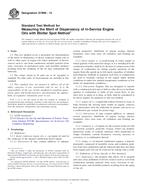
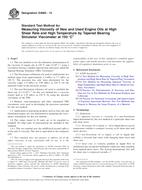 ASTM D4683-13
ASTM D4683-13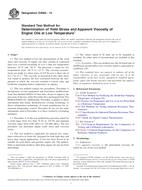 ASTM D4684-14
ASTM D4684-14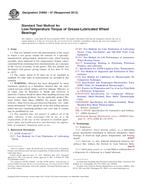 ASTM D4693-07(2012)..
ASTM D4693-07(2012)..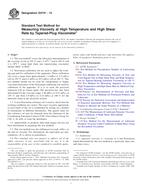 ASTM D4741-13
ASTM D4741-13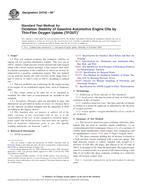 ASTM D4742-08e1
ASTM D4742-08e1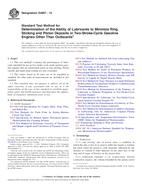 ASTM D4857-12
ASTM D4857-12
 Cookies
Cookies
